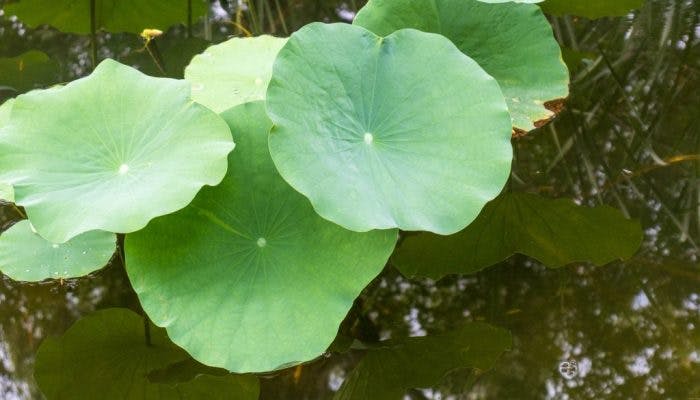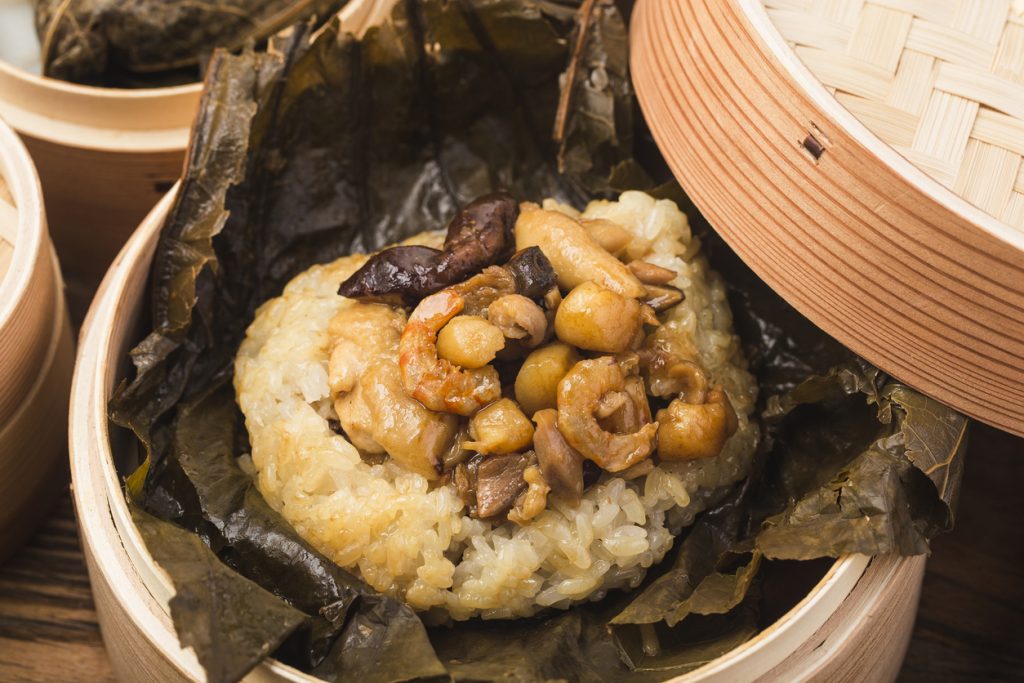Lotus Leaf

What is Lotus Leaf ?
Lotus Leaf (he ye, 荷叶), also known as Folium Nelumninis, refers to the dried leaves of the Lotus, a perennial aquatic plant related to the Water Lily. It grows throughout the tropical regions of Asia and the Middle East, in ponds, lakes and paddy fields. It has vibrant white flowers and light green leaves that can grow extremely large at times, reaching more than 18 inches in diameter.
The plant has fleshy roots that grow breadthways, inflated nodes, many longitudinal vent holes, and exogenous whisker-like adventitious roots. The leaves grow from the nodes and are exposed above the water surface.
They are typically harvested in the Summer and Autumn, cleaned, then dried in the Sun with humidity below 30 percent before getting cut into small pieces.
In Traditional Chinese Medicine (TCM), the Lotus Leaf herb falls under the category of ‘Herbs that clear Heat and purge Fire and clear Summer Heat’. This herb can help to clear inflammatory and infectious conditions that are referred to as ‘Internal Heat’ in TCM, which are usually caused by a Deficiency of Yin or an Excess of Yang.
Neutral in nature and bitter in taste, Lotus Leaf has a cleansing action on the body by clearing Heat, drying Dampness and promoting elimination via urination or bowel movements. In particular, Lotus Leaf is believed to target the Liver, the Spleen and the Stomach.
Functions and Benefits of Lotus Leaf
Traditional Chinese Medicine (TCM) shows that Lotus Leaf has the following health benefits.
Lotus Leaf can help to halt bleeding caused by Heat or Stagnation, as well as to invigorate the blood. It can also treat symptoms of vomiting blood (hematemesis) and blood in the urine (hematuria). It can be used to treat headache, dizziness, abdominal distention, diarrheas, and postpartum persistent flow of lochia too. Lotus Leaf can also help to promote diuresis, which makes it a great weight loss herb to try out instead of going through excessive dieting.
Lotus Leaf can also eliminate summer Heat and lift the Spleen’s yang. It can be used to relieve polydipsia, fever, irritability, excessive sweating, scanty urine, and diarrhea caused by Summer Heat and Dampness.
An active ingredient in Lotus Leaf — nuciferine — has also been found to help reduce muscle spasms. This herb may also help to lower cholesterol levels and blood sugar levels. As Lotus Leaf is packed with antioxidants, it may help to increase blood flow to the Heart and lower blood pressure too. It may be able to prevent diseases such as fatty liver disease as well.
Other than the above Lotus Leaf benefits, it is also suggested that Lotus Leaf may be able to help with premature ejaculation and heavy periods too. Many people also use Lotus Leaf for weight loss and to boost metabolism, promote healthy Liver functions, and expel mucus.
How to Use Lotus Leaf
The recommended daily dosage of Lotus Leaf is 3 – 10g for dried Lotus Leaf, 15 – 30g for fresh Lotus Leaf, and 3 – 10g for charred Lotus Leaf in decoction, pills and powder.
Lotus Leaf is available in its raw form in many markets and Asian specialty stores, while Lotus Leaf supplements are available in many herbal stores.
One of the most common ways to use the raw Lotus Leaf is to package and wrap food. For example, some popular recipes that involve the Lotus Leaf is Lotus Leaf Chicken, Lotus Leaf Wraps and Lotus Leaf Rice.
As for the dried Lotus Leaf, it is more commonly brewed in boiling water to make tea.

Cautions and Side Effects of Lotus Leaf
While Lotus Leaf is very safe for consumption, where long-term usage rarely leads to any adverse reactions, Lotus Leaf should not be used by individuals who are experiencing Cold Deficiency patterns.
Also, pregnant and breastfeeding women should avoid Lotus Leaf for the time being as there is not enough information about the safety of taking Lotus Leaf during these periods.
Also, Lotus Leaf might lower blood sugar levels in some people. Hence, do watch out for signs of low blood sugar and monitor your blood sugar carefully. In particular, individuals who have a scheduled surgery should refrain from using Lotus Leaf at least two weeks before the surgery to prevent it from interfering with blood sugar control during and after surgical procedures.
Summary
Here is a summary for Lotus Leaf:
- Herb name (Chinese): 荷叶
- Herb name (Pin Yin): hé yè
- Herb name (English): Lotus Leaf
- Herb name (Botanical): Folium Nelumbinis
- Origin of species: Nelumbo nucifera Gaertn.
- Part(s) of herb used: Leaf
- Geo-specific habitat(s): Hunan, Fujian, Jiangsu, Zhejiang
- Taste(s) & Properties: Bitter; Neutral; Administrates the Spleen, Liver and Stomach meridians
- Actions: Eases symptoms of heat stroke and bleeding conditions; Helps to improve poor digestive functions with symptoms of diarrhoea
References
Guo, Z., Liu, W., & Su, B. L. (2008). Why so strong for the lotus leaf?. Applied Physics Letters, 93(20), 201909.[Accessed on 15 October 2022]
Huang, C. F., Chen, Y. W., Yang, C. Y., Lin, H. Y., Way, T. D., Chiang, W., & Liu, S. H. (2011). Extract of lotus leaf (Nelumbo nucifera) and its active constituent catechin with insulin secretagogue activity. Journal of Agricultural and Food Chemistry, 59(4), 1087-1094.[Accessed on 15 October 2022]
Wang, Z., Cheng, Y., Zeng, M., Wang, Z., Qin, F., Wang, Y., … & He, Z. (2021). Lotus (Nelumbo nucifera Gaertn.) leaf: A narrative review of its Phytoconstituents, health benefits and food industry applications. Trends in Food Science & Technology, 112, 631-650.[Accessed on 15 October 2022]
Share this article on
